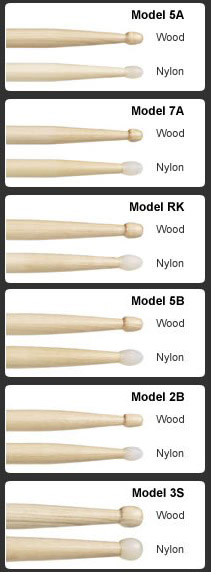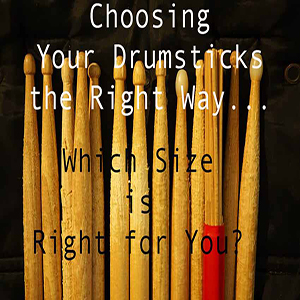Categories: Gear and Hardware
Lets discuss Drumsticks in Depth with Pat Novack
Lets discuss Drumsticks in Depth
As a drummer, you tend to play a wide variety of music, just like a painter uses a variety of brushes and tools in his/her arsenal. You should employ various kinds of sticks to get different effects. Like other things in the musical realm, knowing how to select the best drumsticks is something that needs a bit of knowledge. Or in this case. Research. There are numerous types of drum sticks available in the market. These sticks come in various sizes, shapes as well as different materials composition. Thus, choosing the right drum stick size can prove a daunting task for beginning drummers. Which I am sharing with you now.
Each type of stick has a code that describes it, but the question remains, which stick will suit your particular playing style? And the type of drum you’re playing. In this article, we discussed the best drum sticks for different kinds music. The type and size of drumsticks, and materials, and their applications. This guide will give you more knowledge about the best drumsticks for metal, jazz, marching band, blues that will suit your arsenal. Sometimes the size of a venue can play a role in the type of stick one might grab.
What’s the Drumstick made of?
Most drum sticks are wooden. Rosewood, maple, hickory and Japanese oak are the most popular woods used in the production of the sticks.
Birch is less popular than oak, hickory, and maple, birch produces high-pitched tones on instruments and a super solid cross-stick sound. The stick is ideal for drummers who want a stick with additional weight and heft.
Rosewood is dense hard wood. It has a more musical sound than oak and is a good choice for drum solos. Rosewood drumsticks are more expensive than other woods but are also very durable.
Maple is lighter and softer so it has excellent flexibility thus offering more flex, but it is less durable. When using maple sticks, you will fill less of the hit in your hands since maple is the best for energy absorption.
Hickory is slightly harder as well as more durable than maple. The most popular wood for drumsticks, hickory sticks are resilient, responsive, and sturdy—giving them a “classic” drumstick feel.
Japanese oak is extremely hefty and very long lasting (durable). Oak sticks do not break that much, but you tend to feel the vibrations a lot more due to poor absorption of energy. Which in turn fatigue your hands and fingers faster.
But be warned, if the stick you are selecting does not say what wood it is made of, back away, this means that the stick made of blended wood thus not a standard stick to using.
Apart from the wide spread of wooden drum sticks, an individual may choose carbon fiber, ergonomic sticks, plastic, graphite, fiber glass, aluminum or light emitting diodes (LEDs) sticks that light up upon impact. These types of drums sticks are becoming very popular, aluminum and graphite sticks, they rarely break.

SIZE OF A DRUMSTICK
Once you learn about different types of wood that makes a drumstick, you need to find the perfect size that will suit your need. Although the drum stick sizes may vary from one manufacturer to another, the international accepted drum stick numbering system devised in the 20th century provides the buyer with a rough idea of what to purchase. Generally, there are three categories denoted by letter S, A and B.
The notation A stands for orchestra, B for band and S for street. Class A is the lightest and was primarily designed for large bands while B was originally designed for brass and symphonic bands. The third category, S means street and was designed as the largest as well as heaviest drum stick in the market. The street uses incorporated drum corps plus marching bands designs. The accompanying digits refer to the circumference of the drum stick. The common numbers are two, five and seven. The larger the digit, the smaller the circumference of the drum sticks.
Despite the fact that drum sticks come in various sizes, weights and balances, all of them have similar basic designs. These features are the shoulder (tapered area), tip (which beats the drum head), butt (bottom end), and shaft (straight area which the hand holds). The shoulder can be extremely severe on heavier sticks or gradual on lighter ones.
The round, olive, barrel and pointed tip sticks are the most popular drum sticks in the market. The olive tip provides complete, low tones and enhanced durability, the round is bright and focused, both the barrel and pointed tips provide a medium tone. However, the barrel tip has more focus because of its reduced contact area.
7A is ideal for young drummers who need a lighter drum stick, it is known to be smaller and thinner. They are more lightweight thus offering softer sound when playing the drums. They work best for young drummers, or jazz drumming.
5A drumsticks are the most common kind of drumstick. They have a medium thickness thus allowing a loud and softer sound on your drums. They are commonly used for rock drumming, but you can use them for just any type of drumming. They are the most popular and appropriate drum sticks for standard beginners.
2A and 5B types of drumsticks are known to be much heavier that the other two kinds of sticks. Experienced and hardcore drummers, who want to beat the drum hard like these. As a result, 2a and 5b pack much more power thus allowing for louder sound when you drum. They are ideal for heavy metal rock.
Shape of Tips
Wood and nylon tips produces different quality of sound on the drum set. Different tip shapes provide varying quality of sounds to make a huge pallet of sound selections.
Round tips – Known to produce better sounds on the cymbals with increased clarity.
Barrel Tips – These tips are large, they produce a sounds that seems to vibrate longer.
Pointed or triangle tips – These produce sounds that are between the round and barrel tips
Tear drop or olive shaped – The tip of my drum sticks are of this shape. These are good for a range of sounds from tight, clear sounds to diffused, longer lasting sounds.
Tip designs can affect the sound you’ll produced across the drum set. These subtle differences won’t matter that much for new drummers initially. But as time goes on you begin to critique each and every tone for each and every song.
TAPER
The length of the taper, and stick diameter where it meets the tip, determine how quickly the stick rebounds off drums and cymbals. This can affect tonal brightness and volume. A long taper produces more flex and a faster response, while a short taper is stiffer and offers additional strength. The amount of taper and location of the “shoulder” (where the taper begins) determine the balance of the stick.
The Best Sticks for Rock, Metal and Country
Vic Firth
Vic Firth has a hickory drum sticks which are designed for a much fuller and more pronounced sound. The best brand is Vic Firth’s Extreme 55A is a combination of a 5a and 5b, with enough thickness for playing a metal music. Vic Firth’s Extreme 55A are 16.5 long for additional volume. They are very light thus has a great feel for fast playing.
Vater
Vater Percussion power 5A drumsticks are thicker and have a thick and solid feel in hand. The round tips of Vater Percussion 5A cut through the cymbals thus produces a more acute attack than drum sticks with oval tips. They are versatile enough that you can use them to play other genres of music.
Vater Percussion 1A drumsticks are 17 long which is well balanced thus does not feel heavy at the top. They feel similar to 5B, but they produce much volume with less effort. Even if Vater 1A feel substantial in hand, they are still good enough for fast playing.
Promark Hickory 747
Promark Hickory 747 rock drumsticks are great for metal music. They are fast and produce a loud sound, and they are durable compared to other brands. They feel very light on hand providing much volume.
AHEAD Fat Beat
HEAD fat beat 5A drumsticks are the best sticks for playing metal drums consistently without breaking them. These sticks feel much different because they do not have a natural bounce. They feel very light in hand thus less effort on the drum, but much volume. AHEAD fat beat 5A drumsticks are thinner compared to other sticks. When using them frequently, it is hard for them to break, you can bend but they feature replaceable tips made of plastic, and the shafts are wrapped with a plastic cover. AHEAD fat beat 5A drumsticks are the best for playing metal music.
The Best Sticks for Jazz and easy Blues
A jazz drummer’s stick bag should include quite a few things. However, the main thing should be a few pairs of great drumsticks that are going to cater to the music and help you express yourself in a jazz setting.
The size of drumstick best suited for jazz drumming is the 7A. The reason is because this is a thinner stick compared to the 5 & 2 sizes. You'll generally want a thinner stick for Jazz because you won't be playing as loud and thinner sticks are generally softer in volume.
Vic Firth Peter Erskine Ride Stick
They have a beefed up shaft for extra power, allowing you to play loud dynamics without having to hit too hard. The long taper and back-heavy feel gives them really good rebound. This rebound lends itself well to articulate jazz drumming.
Vic Firth American Classic 7A Nylon Tip
Nylon tip makes the sticks sound brighter on cymbals. The cymbals are almost more important than the drums in jazz, so it’s great to have sticks that accent the cymbals. The Vic Firth 7ANs have a nimble and thin build, yet are somehow very strong.
Zildjian Trilok Gurtu Artist Series
These sticks were designed by the legendary percussionist, Trilok Gurtu. Trilok plays on a percussion setup instead of a standard kit. However, these sticks work great for playing jazz on a drum kit. The unique thing about them is that they have a thumb groove at the fulcrum point. This is an innovation that helps with grip.
Vater Manhattan 7A Wood Tip
Slightly longer than your typical 7A sticks. This gives you a greater reach when playing the drums. The extra length is especially good for playing bells of cymbals, which happens a lot in jazz drumming.
By Pat Novack





